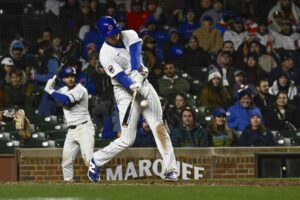Previously, on the Top Ten Comebacks list: we learned that the landscape of baseball in two cities in 1961 was drastically similar. The Washington Senators and Boston Red Sox were both enduring torrential downpours as franchises. Perhaps a case could be made that this is too harsh a judgment towards the Senators, who were in their inaugural season as a franchise. However, calling them as one sees them is an age old baseball adage. If a team loses 100 games in a season, they were categorically bad. The same goes for the Red Sox here, though their downpour was a bit more extensive. They hadn’t been to the World Series since 1946.
So it was, as these two slumbering franchises met on a Sunday afternoon in Mid-June of 1961. Neither team had much to play for at this point. For the Senators, it was a chance to creep closer to the .500 mark. They were 30–32 entering play, ten games behind the Detroit Tigers in the American League. For the Red Sox, it meant trying to widen the gap between themselves and the .500 mark. They stood at an even 30–30, nine games behind Detroit. Both franchises sought improvements, and perhaps they could be made…even in this game. Fenway Park played host to this contest. While the official attendance is not recorded, this writer can imagine the buzz afterward. Let’s dive in and see if we might absorb some of it as well.
The Beginning of an Oddity
Red Sox manager Pinky Higgins sent Ike Delock to the mound. Delock was a veteran who’d been with the Red Sox since his signing in 1948. He never did much, though he did manage an ERA under three in 1959. Washington manager Mickey Vernon countered with lefty Carl Mathias. The 25-year-old was in his second year and first as a starter. They’d drafted him with the 10th pick in their expansion draft the year before. He’d posted a 3.52 ERA in seven games out of the Cleveland Indians’ bullpen in 1960. An interesting side note is that Mathias was a rare switch hitting pitcher. Either way, 1961 would be his final year in the league.
The game began, oddly enough, with 13 consecutive outs between the two. For the first two and a third innings, the two teams couldn’t buy a base hit. That said, five of the 13 outs left the infield, and there were only two strikeouts. So, contact was being achieved a noticeable amount of time. It was simply that the balls were hit in negative ways. Senator catcher Pete Daley broke the streak with a third inning single off Delock. However, this went nowhere as the Red Sox’ starter was able to set down the remaining two in order. Mathias remained perfect through three himself before everything broke loose.
The Comebacks Train Leaves the Station
In the top of the fourth, Delock picked up a quick out. Then, he walked left fielder Gene Woodling before giving up a hit to first baseman Dale Long. Center fielder Willie Tasby followed that up with an RBI double, giving the Senators a 1–0 advantage. Delock walked Jim King to load the bases, then got right fielder Chuck Cottier to ground into an inning ending double play. The Red Sox finally registered their first hit in the bottom of the inning. Later, third baseman Frank Malzone hit a ball that was booted by Senators shortstop Coot Veal. This allowed two runs to cross the plate, giving Boston a 2–1 lead.
Stop One
That was the beginning of the comebacks train. Now, for the first real stop. In the top of the fifth, Daley led off with a double. Mathias then attempted a sacrifice bunt, but Delock misplayed the throw, allowing Daley to come all the way around and score. Veal then sacrificed him to second. After a quick out, Woodling picked up an RBI hit as the Senators regained the lead, making the score 3–2. Long followed that with a two run homer over the Green Monster, extending the lead to 5–2. Things looked bleak for Delock and the Red Sox. However, on this day, comebacks were a dime a dozen.
In the bottom of the inning, the Red Sox picked up another run when center fielder Gary Geiger was plunked with the bases loaded. This glimmer of hope did not last long. New pitcher Billy Muffett allowed Daley to put one over the Monster with a man on base. This extended the Senators’ lead to 7–3. Then, the Red Sox began yet another rally in the train of comebacks. Vic Wertz picked up an RBI via groundout and Don Buddin hit his own Monster shot. The score was 7–5 and the vast field of comebacks was nowhere near finished. The next two frames were uneventful. In fact, after the insanity settled, the pitching staffs managed eight straight outs between them. Then came the ninth, and that’s where this comeback story really blossoms.
Stop Two
Muffett began the inning by allowing a single to Mathias. Yes, Mathias, despite giving up five runs, was still in the contest. This was followed up by a quick strikeout to Veal. Billy Klaus then doubled, sending Mathias to third. This brought on Pinky Higgins and a change on the mound as Ted Wills was called upon. He promptly gave up an RBI hit to Woodling, thus making it 8–5 in favor of Washington. After walking Long, Wills faced down Willy Tasby. The Senators outfielder was never known for having great power. However, he was in the middle of a career high 17 home run season. He lit up the Boston night with a grand slam to right center field. The score was 12–5, and if this writer can imagine, it probably sent many Boston fans scurrying for the exits.
The Final Stop
However, they would soon learn what we’ve already learned: comebacks can happen any time. The bottom of the ninth began with a groundout by Wertz. Then, Buddin picked up a base hit. Pinch hitter Billy Harrell followed that up by striking out. This would be the last out recorded by Senators pitching. Chuck Schilling and Carroll Hardy picked up back-to-back hits, scoring Buddin. Geiger walked, thus bringing manager Mickey Vernon to the mound. Mathias was finally relieved of his duties and Dave Sisler was brought in. This did not go well. Back to back walks to Jackie Jensen and Malzone brought two more runs in. The score was 12–8. Then, things got even more interesting.
Up stepped young catcher Jim Pagliaroni. He had broken into the league with Boston in 1955, but would not get a true chance until 1960. In 1961, he had 16 home runs, and one of his biggest came during this at-bat. He clobbered a grand slam over the Monster, tying the game and, no doubt, sending what remained of the Fenway crowd into a frenzy. Even after this, Sisler remained in the game. A walk to Wertz finally brought Vernon back out and Marty Kuytna came on in relief. He gave up a single to Buddin before finally ending the eight run collapse by allowing a walk-off hit to pinch hitter Russ Nixon. Thus ends one of the longest stories in the entire comebacks arsenal.
When Comebacks Get Weird
Comebacks are interesting little scamps. They come in a variety of forms, whether they be long form or short form. In this case, we had a mixed bag. Both teams practically beat each other to death in order to win. Whether that’s a representation of their moxie or reflective of their respective woes is individual opinion. One thing is for sure, though. These two teams worked together to create a comeback story for the ages. It’s not easily forgotten, despite being a bit lost to time. Hopefully, retelling it will cause people to research more into both it and other similar stories of comebacks.
Main Photo:
Embed from Getty Images
Players/Managers Mentioned:
Pinky Higgins, Ike Delock, Mickey Vernon, Carl Mathias, Pete Daley, Dale Long, Willie Tasby, Jim King, Chuck Cottier, Frank Malzone, Coot Veal, Gary Geiger, Billy Muffett, Vic Wertz, Don Buddin, Billy Klaus, Ted Wills, Billy Harrell, Chuck Schilling, Carroll Hardy, Dave Sisler, Jackie Jensen, Jim Pagliaroni, Russ Nixon






